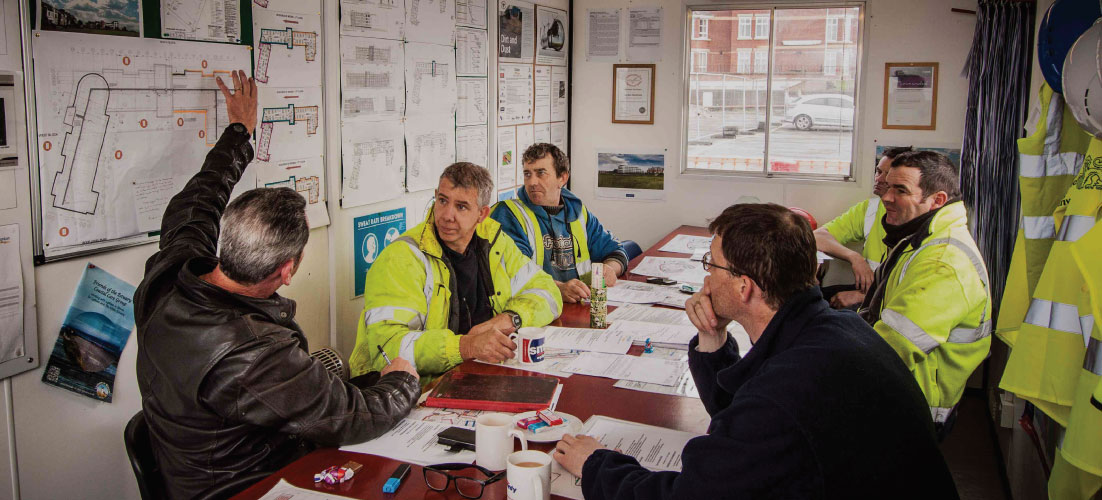
PUBLISHED
May 30, 2018
WRITTEN BY
Ryan LeClaire
“Everybody is doing safety, every day.” That is the most basic description of a High Participation Safety Culture. But achieving it is incredibly complex.
In the previous two steps in The Journey to a High Participation Safety Culture, we’ve seen the CEO commit to safety and empower a safety leader to make it happen. Now it’s time to get employee buy-in from every level of your organization.
How do you destroy the idea that doing things the safe way is doing things the long way? How do you undo safety-bypassing shortcuts that your employees have developed over the years? How do you change decades of unsafe learned behavior in veteran workers? And how do you get them to set the right tone for safety in the younger generation?
Start With Older/ More Experienced Employees
Why begin with the most senior employees?
Some habits span generations and create traditions. Your older workers may have been doing the same work for 30 years. It might be the same work their father did. And their father’s father. Changing their ways now may be considered weak or breaking tradition.
They are the toughest audience to reach. They are also likely to be the people training new employees and telling them, “The safety manual says you need to do this, but you don’t really need to worry about it. I don’t.”
Younger employees have an inherent desire to gain acceptance from this older generation. If safety is treated as a time-waster by the older employees, the younger ones will mirror that. But if tenured employees treat safety as something that ensures their job security, the younger generation will echo that.
Be Completely Transparent
We ended that last section with a potentially foreign concept: “Safety ensures job security.” Let’s unpack that.
Safety absolutely ensures job security.
Your safety record often makes the difference between your company landing a potential contract, or it going to a competitor with a better safety record. A higher safety score means more high-revenue generating contracts. This means more job security and more potential bonuses/ salary raises.
Too many companies shy away from the financial benefits of safety when communicating with employees. They’re worried about creating a perception that, “The company doesn’t actually care about my safety. They’re just worried about the bottom line.”
Don’t hide the financial benefits. Embrace them and shift your messaging to:
A good job is a safe job. You can best provide for your family by ensuring your safety at work and the safety of your colleagues. A strong safety record helps us win contracts, reduce costs and increase profitability. Safe work improves the bottom line and creates job security for everyone.
Don’t be afraid to talk about the economics of safety. Yes, safety is altruistic, but it is also economic and the best safety leaders don’t shy away from this reality. You can read the data to back this up by clicking here.
Personify Safety
Once you’ve begun to get buy-in, we have identified two tactics to reinforce this newfound commitment: A branded safety initiative and a visible safety symbol.
Branded Safety
Your branded safety initiative can be a simple slogan and/or a logo. You need a recognizable and repeatable brand to build awareness. And it should be everywhere, including every email signature, letterhead, and slide-deck.
One of the companies we’ve studied, Roseburg Forest Products, has about 5,000 employees across approximately 20 sites in Canada and the United States. They created a program called, Zero to the Core. They put the logo on everything. They repeat Zero to the Core every time they have a platform to do it. They host Zero to the Core BBQs to show their commitment. It’s part of their everyday vocabulary.
A Safety Symbol
Introduce a visible symbol that demonstrates your CEO’s commitment.
For example, one of the companies in our study initiated a back-in parking program for all their employees. Their CEO’s truck was the first one at work every morning and the one parked closest to the front door. That truck was a constant reminder of the new culture.
It symbolized that the most influential person in the company has made a commitment to safety, challenging everyone else to do the same.
Building this High Participation Safety Culture isn’t going to happen overnight; nothing worthwhile does. However, if you’re patient and strategic in how you introduce this change, you’re going to see results a lot faster than you think.
Begin with your most tenured employees. Start by changing their minds about how important safety is, then task them with influencing the younger generation. At the same time, personify your safety culture with a branded statement or slogan, while introducing a symbol that shows the world that you’re serious about safety.
That’s the third phase. If you would like to read the entire journey, download our whitepaper, Building a High Participation Safety Culture.
Rethinking Safety
Drive employee engagement by connecting
your frontline to your boardroom.
Find Out How eCompliance Helped Zip Signs Achieve COR Certification.
READ CASE STUDY →